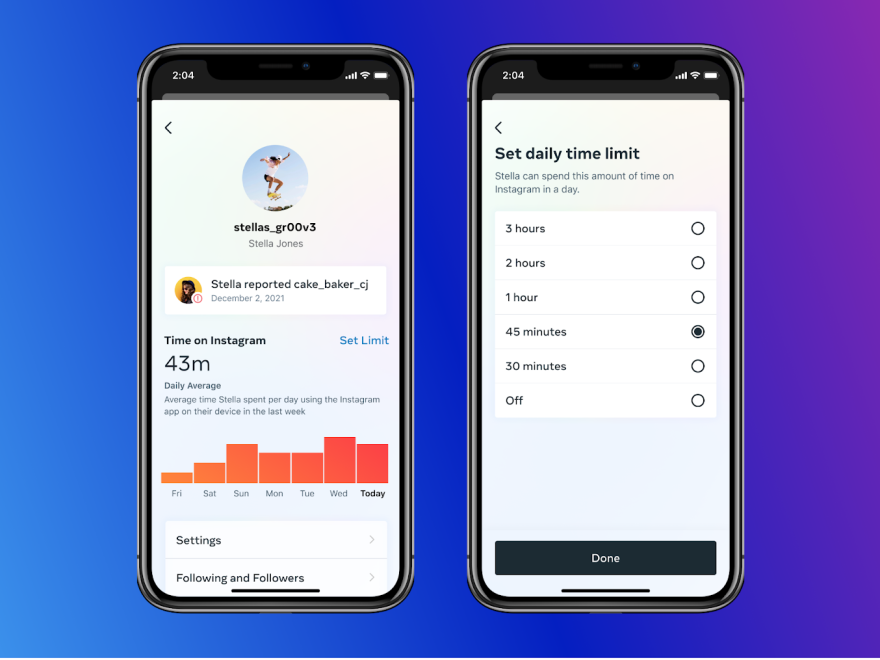Instagram is rolling out a new set of safety features aimed at its youngest users and their parents, a day before the photo-sharing app's head testifies to Congress about the platform's potential risks to kids and teens.
They include tools to help users manage how much time they spend on the app, limits on both unwanted interactions with adults and exposure to sensitive content, and optional parental oversight of children's accounts.
Instagram, which is owned by Meta (formerly Facebook), has come under intense scrutiny since a whistleblower disclosed internal research showing the app can harm users, including by exacerbating body image issues and other mental health concerns for some teenage girls. A bipartisan group of state attorneys general is investigating the company, and lawmakers are holding hearings about child safety on social media.
On Wednesday, Instagram head Adam Mosseri will testify before the Senate Subcommittee on Consumer Protection, Product Safety and Data Security. He's expected to be grilled on what Instagram knows about its potential harm to young users and what the company is doing about those concerns.
"I'm proud that our platform is a place where teens can spend time with the people they care about, explore their interests, and explore who they are," Mosseri wrote in a blog post on Tuesday announcing the new features. "I want to make sure that it stays that way, which means above all keeping them safe on Instagram. We'll continue doing research, consulting with experts, and testing new concepts to better serve teens."
Instagram is walking a fine line between assuring families that it is doing all it can to keep their children safe, while competing with apps more popular among young people, such as TikTok. Under pressure in September, Instagram paused work on a version of its app for children under 13, saying it would work more closely with parents, experts and lawmakers before proceeding.
Sen. Marsha Blackburn of Tennessee, the top Republican on the subcommittee holding Wednesday's hearing, slammed the company's announcement, saying it "will do little to substantively make their products safer for kids and teens."
"Meta is attempting to shift attention from their mistakes by rolling out parental guides, use timers, and content control features that consumers should have had all along," she said.
Safety features include parental controls and restrictions on tagging images of kids
Instagram said it will launch a number of features and tests immediately and others in the coming months.
The company says parents and guardians will be able to see how much time their children are spending on Instagram and set daily time limits. Users under 18 will also be able to notify their parents or guardians when they report problems like bullying or harassment by other users. However, in order for parents to use these tools, their kids need to opt in.
"The emphasis is really on what type of insights into teen behavior can we provide parents and what type of controls can we provide that are valuable both for parents and teens to open up that dialogue between them?" said Vaishnavi J, Instagram's head of safety and wellbeing.
The company is also creating an "educational hub" for parents with tutorials on how to use Instagram and tips on discussing social media with their kids. Those features will be available starting in March 2022.
In the meantime, Instagram is rolling out its new "Take A Break" feature in the U.S., U.K., Canada and Australia. The feature, first announced in October amid pressure over the whistleblower's revelations, lets users set a reminder to step away from the app after a set amount of time. While the feature is available to users of all ages, those under 18 will see a special prompt.
In another new change, by default, users now won't be able to tag or mention people younger than 16 who don't follow them, to minimize unwanted or inappropriate interactions. That builds on changes Instagram announced in July that made accounts for kids under 16 private automatically and limited the ability of some adults to interact with and follow teens.
Going forward, Instagram will more strictly limit what posts and accounts it recommends to users under 18, so that they are less likely to encounter posts considered "sensitive."
The company has also begun testing "nudges" — alerts prompting users to check out other subjects if they seem to be going down a "rabbit hole," J said. It's exploring how these nudges will work before deciding whether to roll them out more widely and isn't focusing on any specific topics, she added.

"Any one piece of content is unlikely to make you feel good or bad or negative about yourself," she said. "It's really when you're viewing, say, 20 minutes of that content or multiple pieces of that content in rapid succession that may have a negative impact on how you feel."
Another feature Instagram plans to roll out to all users in January is the ability to delete in bulk their posts, likes and comments. J said the goal is to let users manage their online "footprint," and give younger users in particular a greater sense of control over what they decide to share.
Editor's note: Meta pays NPR to license NPR content.
Copyright 2021 NPR. To see more, visit https://www.npr.org. 9(MDAyNDY5MjM1MDEyODE2MzMyMTZmZDQwMg001))




